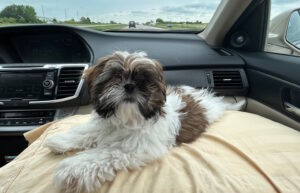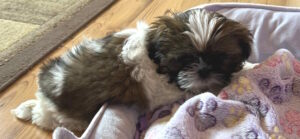I finally managed to order some extra puppy training devices for Daisy today. She has gone from a quiet, cuddly ball of fur to a cat-terrorizing, barking, chewing flash of energetic fuzz, zipping here and there. Initially, when we brought Daisy Mae home, she was quiet and docile. She did not whine or whimper. After about three days, she perked up, and life has not been the same. She began chasing after the cats, wanting to play with them. The cats do not want to play her games.
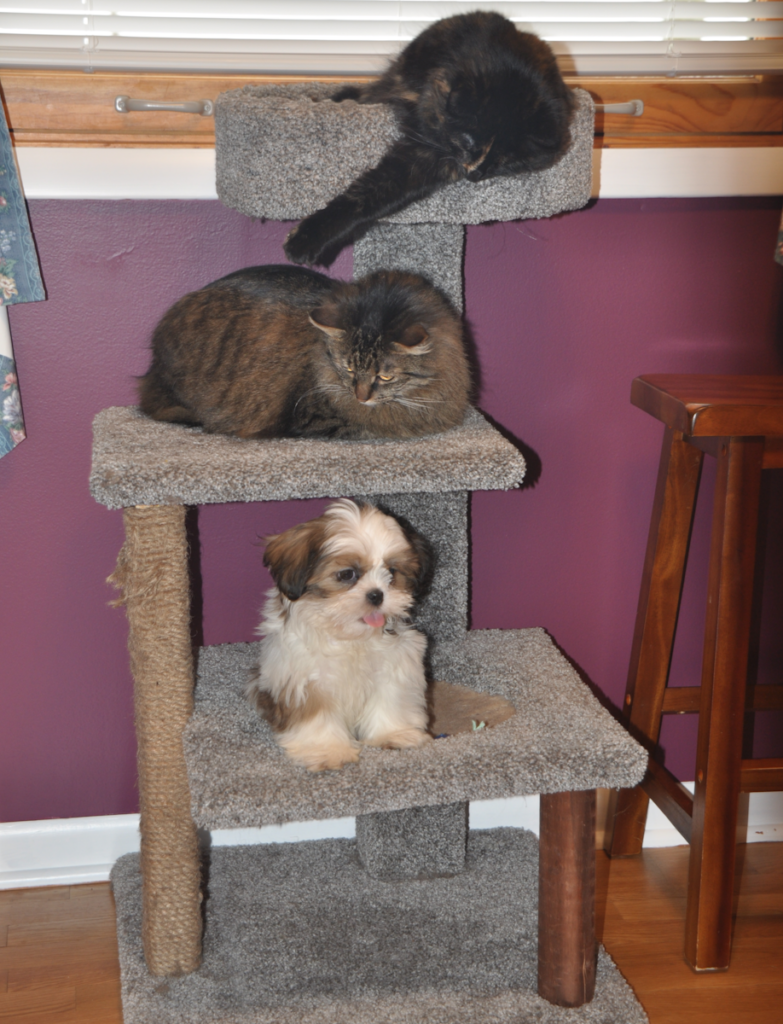
Potty Training Challenges
Regarding the training issues, Daisy goes to the bathroom in all the places except where she is supposed to go. She doesn’t use the puppy pads we purchased and ignores the potty-training spray we put on them. Our puppy plays when we go outside but will not “go.” However, when out of my eyesight for five seconds, she goes.
The kitchen mat, dining room rug, office rug, utility room rug, cat mat, office mat, and sometimes just the floor have all become bathroom spots. Daisy gets so caught up in play that she doesn’t realize she needs to go back to the utility room to go potty. This adorable, fluffy bundle of energy has us shaking our heads at her capers as we clean up after her. A lot of puppy training lies ahead. On a positive note, she has not made any messes in her kennel.
Training Tools and Techniques
House training is often the most challenging aspect of raising a puppy, and Daisy is proving this rule true. Apparently, the inconsistency we’re experiencing is actually quite normal for young puppies who are still developing bladder control and learning to recognize their body’s signals.
Why aren’t the puppy pads working? Puppies often don’t intuitively understand what these strange surfaces are for. The training spray contains pheromones meant to attract dogs to eliminate in that spot, but some simply aren’t responsive to these artificial scents. One suggestion I have yet to try is placing a small amount of her own urine (collected with a paper towel) on the pad to help her recognize this as an appropriate spot.
According to research, when a puppy doesn’t “go” outside despite clearly needing to, it’s often because he’s too distracted by the exciting outdoor environment. Taking him to the same spot each time, using a consistent command word like “potty” or “business,” and waiting at least 15 minutes without play or interaction can help him focus on the task at hand. If he still doesn’t go, bringing him back inside but keeping him in his crate for 10-15 minutes before trying again often works wonders.
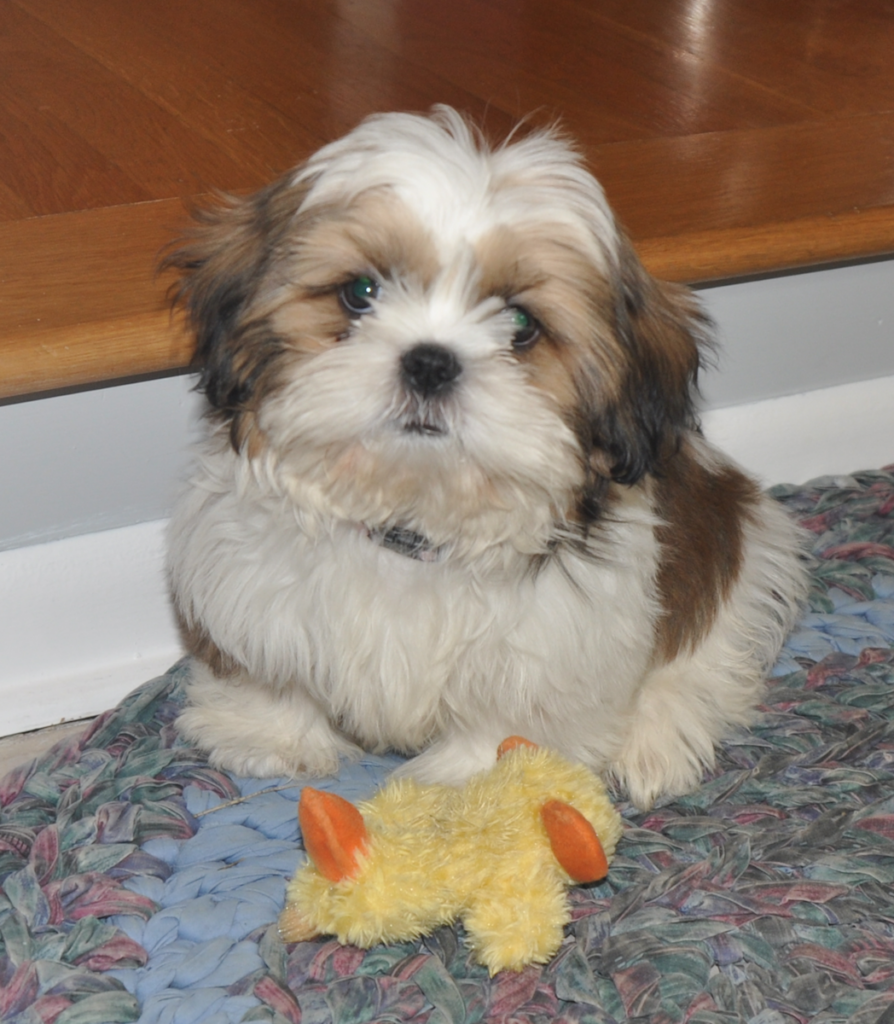
Sisterly Advice
My sister, Becky, has a couple of dogs. One is a Shih Tzu, like Daisy. Becky suggested shrinking the size of the kennel so Daisy doesn’t make a mess, and so far, that has worked. I think Daisy is starting to get the hang of it.
The reduced kennel size technique that Becky suggested works because dogs naturally avoid soiling their sleeping areas. This capitalizes on their instinct for cleanliness and helps reinforce bladder control. As your puppy demonstrates that he can hold it longer, you can gradually increase his space.
Becky also has a set of jingle bells at her back door. She has taught her dogs to ring the bells when they need to go outside. I decided to purchase some. I had no idea there is actually such a thing as “dog training bells.” However, they are bulky and big. I want something that is small and nice-looking since they are going to be there long term. I am going to try a small garden chime, only about 12 inches in height. I also purchased a small strand of bells on a woven rope, which is nicer décor than just leather jingle bells. Hoping Daisy will not shred them in the process.
Managing Common Puppy Behaviors
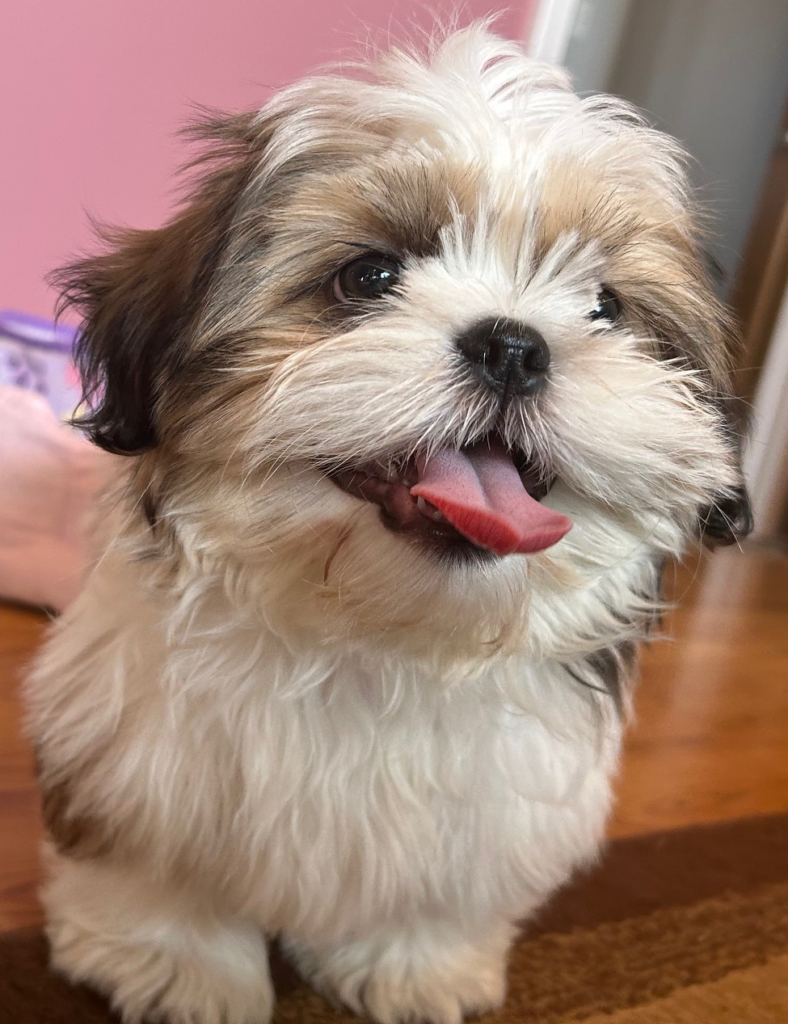
The Chewing Phase
Our fur baby has become a living shredder. Ping-pong balls don’t stand a chance against her sharp puppy teeth. This destructive chewing is completely normal—puppies explore their world through their mouths and are also teething. Our puppy is likely experiencing discomfort as her adult teeth come in, which typically happens between 3–7 months of age.
I’ve purchased yak cheese, another wise suggestion from Becky, which is great for indoor dogs. It doesn’t smell, go bad, or fall apart, and it lasts a long time. It is a natural alternative for bones and also good for their teeth. The hardness provides relief for sore gums while being durable enough to withstand determined chewing.
The key to managing chewing is consistent redirection. Whenever Daisy grabs a shoe (and there are many by the back door to choose from), I get a toy to give her and take the shoe away. As soon as the yak cheese arrives, I’ll trade the leather boots she’s chewing for the cheese. Just a caution: there are different sizes of yak cheese, so choose the one for the size of your dog.
For items that can’t be moved out of reach, bitter apple spray or similar deterrents can make forbidden objects taste unpleasant. Rotating toys regularly can also help maintain your puppy’s interest in the appropriate chew items.
Cat Chasing and High Energy
Daisy’s desire to chase the cats is driven by her natural prey drive and playful nature. According to some helpful internet sites, the following tips can help manage this behavior:
- Create positive associations between your puppy and the cats by rewarding calm behavior around them.
- Ensuring your puppy gets sufficient exercise elsewhere helps reduce the need to chase cats for stimulation.
- Providing safe spaces for the cats to retreat where your new family member can’t access them gives everyone some peace.
For seemingly boundless energy, consider implementing structured play sessions followed by enforced nap times. Puppies, much like toddlers, can become overtired and hyperactive when they need rest. Short training sessions of 5–10 minutes several times a day can also help to mentally tire her out.
Progress Report
My order came in, and I now have a set of bells by the back door, so right before we go outside, we have Daisy ring the bell with her paws and then take her out. She’s still trying to get the hang of it and has gone outside several times. If she does not go, but I think she needs to, I put her back into her cage for 20–30 minutes and then repeat the going-outside process.
I am certain there will be more memorable stories to share in the days ahead.
Puppy Development Timeline and Expectations
Understanding what to expect during the first year of a puppy’s life can help you stay patient and consistent with training. Here’s a general timeline of what what lies ahead:

8-10 Weeks: Foundation Period
- Basic household routines and crate training introduction
- Beginning of potty training (expect accidents, especially at night)
- Initial socialization with household members
- Introduction to collar and leash (brief, positive experiences)
10-12 Weeks: Learning and Awareness
- More consistent bladder control during crate time but still frequent accidents
- Teething begins: increased need for appropriate chew toys
- Starting to form associations with training cues
- Energy levels increasing dramatically
3-4 Months: New Challenges
- Teething intensifies; expect peak chewing behavior
- Capable of longer periods without elimination (2-3 hours)
- Ready for basic commands (sit, down, come)
- May enter a fear period—need for positive socialization experiences
4-6 Months: Building Reliability
- Should be mostly potty trained with occasional accidents
- Adult teeth coming in—cheating should gradually decrease
- Can begin more structured training sessions
- Bell training should be well-established
6-12 Months: Adolescence
- Physically capable of full bladder control
- May test boundaries and “forget” training
- Increased independence
- Energy levels peak before gradually settling
Following this timeline helps set realistic expectations. Full, reliable house training typically takes 4–6 months, but with small breeds like Shih tzus, it may take a bit longer. Teething and its associated chewing typically subside around 7–8 months when all adult teeth are in. The challenging adolescent period that begins around 6 months requires renewed consistency but eventually gives way to a well-mannered dog.
Helpful Puppy Training Tips
- Consistency is key in potty training—take your puppy out frequently and on a regular schedule.
- Reward successful outdoor potty breaks immediately with treats and praise.
- Consider crate training as a helpful tool for house training.
- Provide appropriate chew toys to redirect destructive chewing.
- Use positive reinforcement techniques instead of punishment.
- Be patient—puppies typically take 4–6 months to be fully house trained.
- Establish a routine for feeding, playing, and bathroom breaks.
- Clean accidents thoroughly with enzymatic cleaners to remove odors.
- Consider bell training to help your puppy communicate when they need to go out.
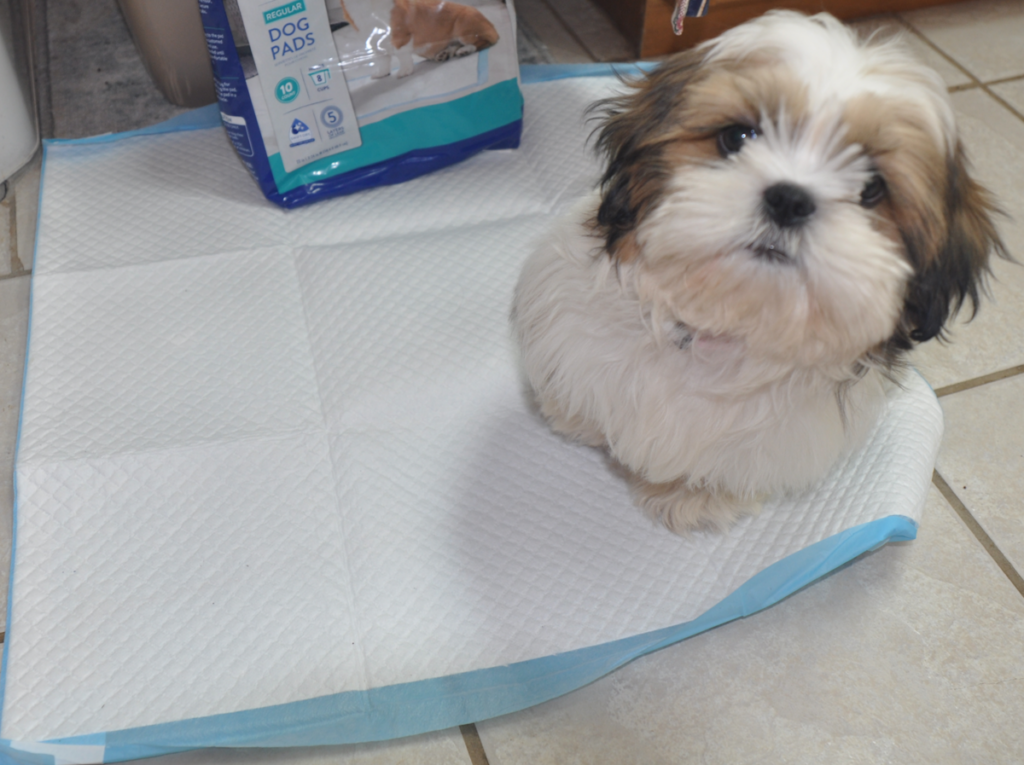
Life With a Puppy
Becky commented that I will probably not get much done with a puppy in the house. I think she might be right; I spend half my day just watching Daisy Mae race around the house or play fetch with me. I am enjoying every minute. I have always wanted a fetch-playing dog. In the past, I attempted to teach our old English sheepdog, but she never caught on.
Puppy Responsibilities & Children
Though my children are both adults now, I still involve them in Daisy’s care. Young children can benefit both educationally and by being entertained. Your children can learn to take responsibility for filling the water bowl and helping with the morning feeding routine. They can also work with teaching simple commands like sit. Do not fret if the training session turns into a play session instead; they are both learning lots.
Your can appoint a “toy monitor,” making sure the toys are picked up at the end of the day and not scattered throughout the house. Grooming is another essential job for some dogs, gently brushing the coat and talking softly. You will be amazed at the heartwarming bond that begins to form between your children and your new pet.
Children can take turns accompanying you on walks, learning about the responsibility of regular exercise, and picking up after your puppy. These shared duties not only ease your workload but teach your children valuable lessons about caring for another living being. Watching them grow more confident and responsible through these simple puppy duties will be an unexpected bonus of welcoming your puppy into your family.
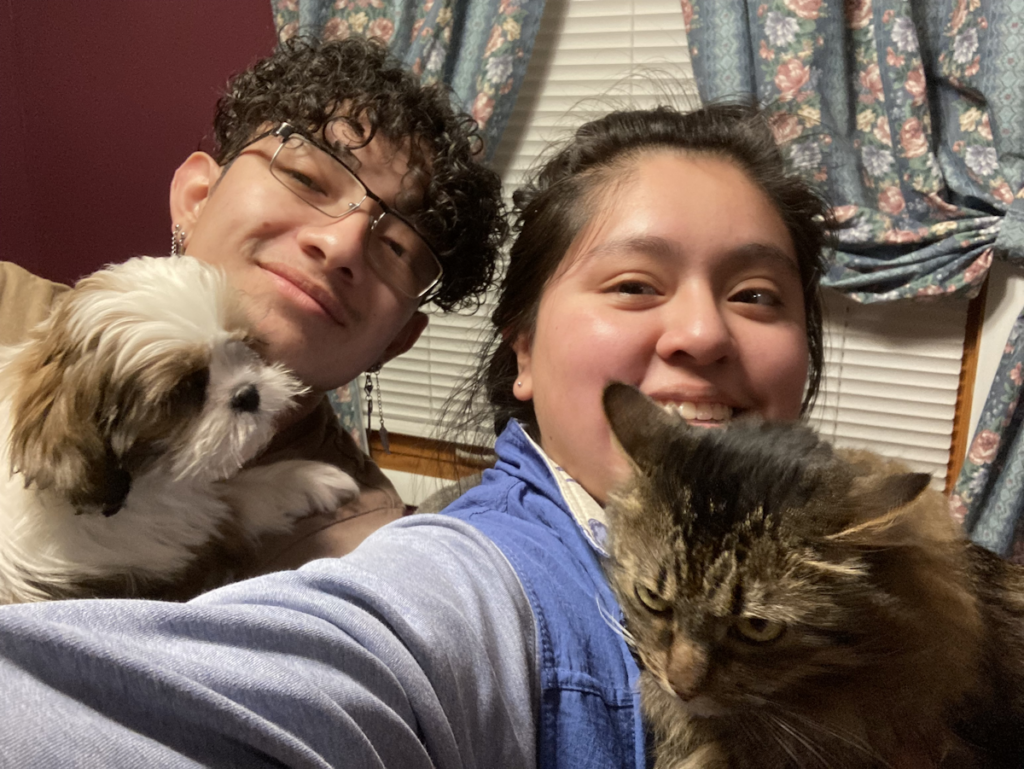
Pets Can Change Our Parenting
Training a puppy like Daisy requires patience, consistency, and a good sense of humor. Some days feel like two steps forward and one step back, especially with potty training. But those moments when she rings the bell to go outside or chooses her chew toy over my shoes make all the challenges worthwhile.
Our pets depend on us for their well-being. The time and effort we invest in their training and care build a bond that lasts a lifetime. Through this experience, I’ve learned to celebrate small victories, find joy in simple moments, and appreciate the unconditional love that comes with having a pet.
The patience we show during frustrating training moments teaches compassion, not just to our pets but also to those around us. Our actions set an example of kindness and responsibility, shaping how others, especially the next generation, treat animals.
So, embrace the adventure. Celebrate the victories, big or small. Cherish the quiet moments of connection. Because in the end, we’re not just raising well-behaved pets—we’re nurturing a more compassionate home and community, one paw print at a time.

